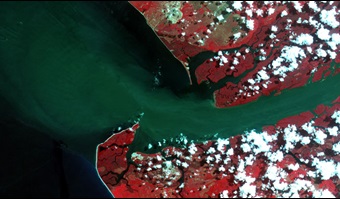Angola-LNG is assisted by DHI to get LNG carriers safely through troubled waters
Highly density-stratified waters are known to pose particular challenges to navigating ships. Such conditions prevail at the mouth of the Congo River, where Angola LNG has just established a new loading facility near Soyo.
Highly density-stratified waters are known to pose particular challenges to navigating ships. Such conditions prevail at the mouth of the Congo River, where Angola LNG has just established a new loading facility near Soyo. This strong stratification at a river mouth may involve formation of subsurface waves that significantly hamper navigation. As support to captains and in order to ascertain maximum safety for the LNG carriers calling at the new terminal, Angola LNG retained DHI to investigate the influence of the stratified flow on ships’ manoeuvring properties.
Flow stratification may occur where fresh water and saline sea water meet, for example in harbours, locks and river mouths, or at locations where large differences in water temperature prevail. When non-saline, light river water discharges from the Congo River into the colder and heavier saline sea water, a strong density stratification is formed at the river mouth: an upper layer of relatively light water flowing at high current speeds develops on top of the heavier and often slowly moving saline sea water layer underneath. A detailed understanding of how this stratified flow changes the manoeuvring properties for ships in terms of flow resistance on the vessel as compared to non-stratified waters is crucial for captains in order to steer their ships with full confidence.
Accurately assessing the impacts of stratified flow on ship resistance requires a detailed knowledge of the flow field including turbulent mixing and in particular the generation of internal waves on the interface between the two layers of water, related to the so called “dead water” phenomenon.
|

Figure 1: Arial photograph of the mouth of the Congo River (by courtesy of Angola LNG; www.angolalng.com). |
Figure 2: Mixing of the two densities (represented by red and blue, respectively) around the ship hull
In a recent study, DHI investigated the ship-flow interaction in stratified waters applying advanced Computational Fluid Dynamics (CFD) methods, using the open-source CFD platform OpenFOAM®. Analyses of the flow field under a range of different navigation and flow conditions revealed, amongst other results, a strong interdependency between ship speed and the drag resistance. Through the CFD simulations and analyses, DHI was able to demonstrate to pilot’s ways to overcome this enhanced resistance problem when navigating in the stratified waters to and from the LNG terminal.
The results of DHI’s study also formed input to a navigation training programme conducted for captains and pilots at the navigation simulations centre of FORCE Technology located near DHI’s head quarter in Denmark.
The present investigations are part of a comprehensive program of studies carried out by DHI for Angola LNG.
Figure 3: Internal waves developing around the hull at supercritical speed |
Figure 4: Large longitudinal coherent structures developed all the way along the sides of the hull in the case of two-layer fluid flow. Thus enhanced mixing of the two fluids is observed at supercritical speed. |
Read more